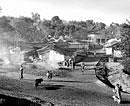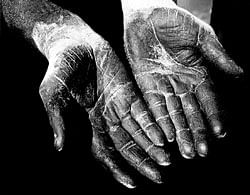

Srikanth Kolari’s photographs of life in the burning coalfields of Jharia in Jharkhand, conflict-corners of Kashmir, and the tsunami-hit coast of Tamil Nadu urge viewers to seek out and interpret deeper stories behind each image. He portrays the many shades and shadows of grief, compelling us to confront deep-rooted scars and festering emotional wounds. A major underlying theme of all Srikanth’s projects is the problems faced by humanity. He strives to “focus the spotlight” on poor, marginalised people living on the edge.
Srikanth’s images from coastal Tamil Nadu show the many scars left by tsunami. The care-worn face of Amma Kannu shows stoic forbearance as she stands at the threshold of her dark, empty home. Her husband, a fisherman, was swept away by the sea. His body was never found. She herself was carried all the way to the mangroves and rescued by some villagers. She now lives all alone with her two goats and haunting memories. Today, fishermen continue to brave the waves in flimsy catamarans; tiny specks in the horizon vulnerable to choppy waters and angry grey skies. Even children take makeshift rafts into the mangroves and backwaters in search of fish. They have lost everything; their homes, loved ones, and their boats and fishing nets, the tools of their livelihood. Their memories haunt them and they fear the wrath of the sea. Yet, they have no choice for they must eke out a living. The progress of rehabilitation projects is pathetic. Ruins of slums along Marina beach await fresh construction. Some new houses provided by the local NGO in low lying areas of Kadalur district get flooded after just a few hours of rain. Yet, life goes on. It must. Fishermen and shoppers strike bargains in the daily fish market on Marina beach, Chennai. Dark clouds loom ominously overhead, while the furious sea roars in the backdrop. A crow flies off in a halo of light; a harbinger of hope or warning of disasters. Srikanth leaves it to viewers to make their own interpretations.
The Jharia coalfield in Jharkhand is a storehouse of our country’s prime coking coal. The area is also threatened by over 70 mine fires. “Once a coal seam catches fire, and efforts to stop it at an early stage fail, it may continue to burn for tens to hundreds of years,” according to The Energy and Resources Institute (TERI). “In India, the fire in the Jharia coalfield has mainly been due to unscientific mining and extraction of coal in the past...
Besides burning away of an important energy resource, it creates problems for exploitation of coal, poses danger to humankind, raises temperature of the area, and when present underground, can cause land to subside. The pollution caused by fires affects air, water and land.”
Srikanth captures the anxiety of the miners as they approach the shaft entrance. Will there be another accident? How will they make ends meet after an exhausting day-long shift? A close-up of a miner’s hands shows calloused, creased palms blackened by coal. The skies here are perpetually fogged by sulphurous smoke rising from burning mines. Their water sources are contaminated. These miners live and die in coal dust laden poverty. Yet, they do pause for smiling group photos before their hovels.
Srikanth’s snapshots of Kashmir capture the deep psychological gashes left by 20 years of insurgency. Nearly 90% of the valley’s population is estimated to suffer from chronic post-traumatic stress disorders, drug abuse, and suicidal tendencies. The patients who wait for a doctor at a hospital are lucky. Countless other victims living in remote areas have no access to medical help. Meet Ghulam Nabi Khan, who was shot in the leg by security forces. They also gave electric shocks to his wife in the eye. This elderly couple live in utter penury, and involuntarily begin to shiver whenever they see men-in-uniform.
Zulaikha, who is now 21, was gang raped at the age of 12 by security forces in front of her brother and other children of the village. Two years later, her brother was killed as a suspected militant. Shareefa, 26, and Fahmeeda, 22, of Watlar village, live in a stinking corner of their cottage. In 1995, these girls witnessed a major blast through their window. Since then, they speak to nobody except each other, cry for days on end, and waste their young lives staring dejectedly out of their window. Srikanth’s photographs capture these victims in various stages of fear and sorrow. They are like characters in some fiery Shakespearean tragedy; a tragedy with no cathartic resolution in sight.
A free spirit and a “photographer by accident,” Srikanth quit his job in Outlook and began to travel with his wife across the world on a “self-discovery trip.” He observed first-hand the social issues and problems people faced, connected with them easily, and the striking images “happened.” As he travelled and shot these images over the course of several years, “people whom I met spoke everything about their lives to me. They spoke about their humiliations, their sufferings, their hopelessness and pennilessness and also about the rapes of their daughters. I was a stranger, yet they poured out their grief. “
In the course of his career, Srikanth has focused on social, political and economic issues such as the struggles faced by child labourers, AIDS patients and their near and dear ones, sex workers, migrant workers and others. “I’m more comfortable in villages than in the cushy comfort of cities like Bangalore,” he says. He takes out his camera to shoot his subjects, “after I have heard the story; a story that is in need of a messenger. My photographs are all about them. My own emotions and thoughts as I interacted with and photographed them, are not important at this point of time. It is my personal choice to photograph them. But they have no choice.” They are victims compelled by poverty and lack of options to struggle to survive in difficult circumstances. He hopes these silent pictures will speak to the passionate few who will care and initiate positive change.
(The exhibition is on till April 20 in Bangalore.)